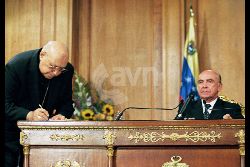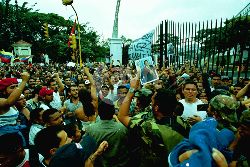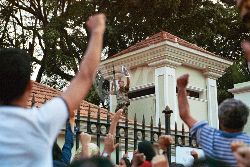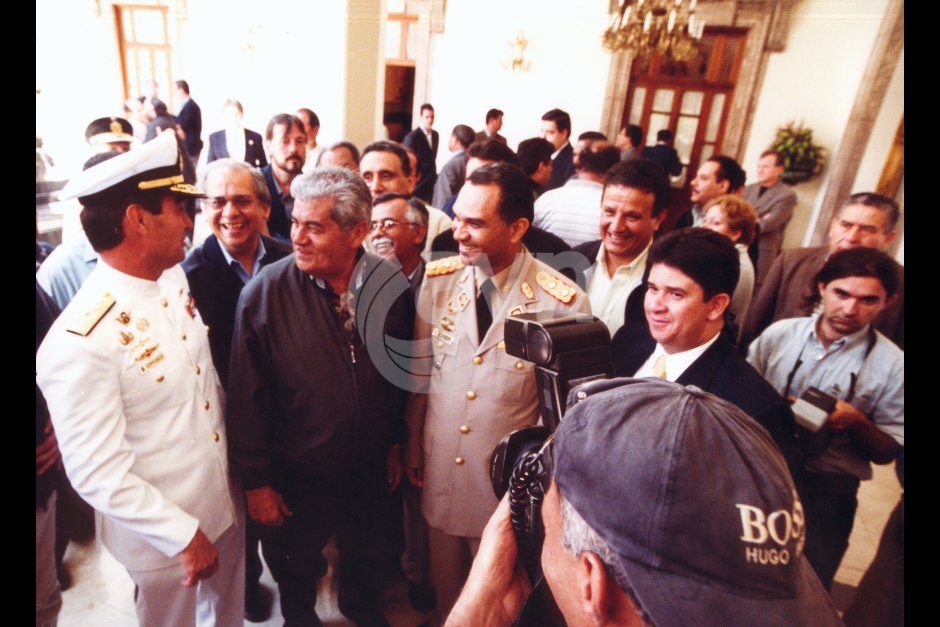Ten years after the defeat of the coup in Venezuela by the revolutionary mobilisation of the masses it is worth looking back at the forces that were behind the coup, the reasons why it was defeated and what happened afterwards, as those events hold the clue to the class dynamics of the Venezuelan revolution.
 Church support for Carmona Photo: AVNPresident Hugo Chavez came to power in 1998 on the basis of an electoral platform which promised to do way with the hated Punto Fijo system, put an end to corruption and eradicate poverty. The Punto Fijo agreement signed in 1958 basically consolidated a two-party system between the Christian Democratic COPEI and the social-democratic AD. The two parties agreed to share all institutions of state power, the judiciary, the trade unions, civil society organisations, etc. in an amicable agreement. The people were allowed to vote for either one of the parties, but the oligarchy would remain firmly in power. The system was sustained by extended networks of patronage in which both adecos [AD] and copeyanos [COPIEI] were able to give out jobs and subsidies to large numbers of people to guarantee their political allegiance.
Church support for Carmona Photo: AVNPresident Hugo Chavez came to power in 1998 on the basis of an electoral platform which promised to do way with the hated Punto Fijo system, put an end to corruption and eradicate poverty. The Punto Fijo agreement signed in 1958 basically consolidated a two-party system between the Christian Democratic COPEI and the social-democratic AD. The two parties agreed to share all institutions of state power, the judiciary, the trade unions, civil society organisations, etc. in an amicable agreement. The people were allowed to vote for either one of the parties, but the oligarchy would remain firmly in power. The system was sustained by extended networks of patronage in which both adecos [AD] and copeyanos [COPIEI] were able to give out jobs and subsidies to large numbers of people to guarantee their political allegiance.
As long as oil revenues flowed into the state coffers, allowing a certain degree of development and social spending, this limited bourgeois democracy was the best way for the Venezuelan ruling class to maintain its rule. It all came to an end, however, in February 1989, when the masses rose up against an IMF-imposed austerity programme introduced by the ADeco Carlos Andrés Pérez.
The government brought the army out onto the streets to smash the popular uprising known as the Caracazo, killing thousands in the process. That produced a massive fracture in the system. The masses, which had generally been apathetic towards puntofijismo had now risen up against it. The illusion of “democracy” had been broken by the realisation that the oligarchy could only stay in power by brutally suppressing the people. On the other hand, a group of patriotic nationalist junior military officers were profoundly repelled by the idea of the Army being used against the Venezuelan people. Amongst these officers who looked for inspiration to the figure of Simón Bolivar (the hero of Latin American liberation from Spanish colonial domination), was Hugo Chavez.
The failed attempted military uprising in 1992 against the old system was a direct consequence of the Caracazo. However, although it was defeated it established Hugo Chavez as a figurehead which concentrated the whole of the seething hatred of the masses against the old order. In fact, the Caldera government, which replaced Carlos Andres Perez, was forced to release Chavez and his fellow conspirators under the pressure of the masses.
When Chavez’s Revolutionary Bolivarian Movement 200 (MBR-200) finally decided to stand in the 1998 presidential elections the Punto Fijo regime was already mortally wounded. The favourite candidate of the oligarchy in those elections was Irene Saez, a former Miss Universe standing on a programme of ending corruption and bureaucracy, and presenting herself as an anti-establishment candidate. At the end of 1997 she had 70% in the opinion polls and later won the official endorsement of COPEI. However, she was also the mayor of Chacao, the wealthiest of the Caracas municipalities, and everything about her represented the wealthy, Westernised upper middle class, completely devoid of any substance and with no links to the millions of oppressed workers and poor in the barrios surrounding the capital.
It was clear that none of the candidates of the two main parties of the ruling class had any chance of winning and AD and COPEI kept changing theirs. Days before the election they decided to throw their weight behind Salas Romer, the wealthy governor of Carabobo, who belonged to the ruling class but wanted to distance himself from the puntofijista parties and had created his own Proyecto Venezuela.
The campaign really revealed the depth of class polarisation in Venezuelan society. Speaking the plain and colloquial language of the people Hugo Chavez travelled the length and breadth of the country engaging in a dialogue with hundreds of thousands in the poorest and most oppressed layers. His message was simple, clear and appealing: against the old order. For the first time in decades they were drawn into political activity, as they saw a candidate which they could identify with and whom they considered reflected their interests and aspirations.
His programme was certainly not socialist and he even toyed with the idea of the “third way.” There was even a section of the Venezuelan ruling class which backed his campaign in the hope of using him as a battering ram to clean the façade of Venezuelan politics and give bourgeois democracy a new lease of life.
However, the class interests of the forces that had gathered behind his campaign, the people who had risen up in February 1989, were fundamentally in contradiction with the interests of the landlords, capitalists, bankers, media owners and wealthy parasites which formed the Venezuelan oligarchy, a tightly knit group of about 100 families with grand sounding surnames which had ruled the country for nearly 200 years.
Finally, in December 1998 Chávez achieved a massive victory, winning 56% of the vote against 38.9% of the candidate of the oligarchy, Salas Romer. That marked the formal end of puntofijismo, though the oligarchy remained firmly in power.
Hugo Chavez took a number of bold steps to do away with the old political system, by calling a referendum on the convening of a constituent assembly (which was won with over 87% of the votes), elections to the constituent assembly itself (where Bolivarian candidates won 95% of the seats), a referendum on the new constitution (which was approved by 71% of the votes) and finally new presidential elections in 2000 (which he won with 59% of the votes).
All this solidified his support amongst the masses and introduced a number of democratic reforms to the political system, which however, remained firmly within the limits of capitalism. The ruling class was increasingly afraid of the revolutionary potential of the Bolivarian movement, particularly the fact that the masses of the people were now directly participating in politics, with hundreds of thousands getting organised at a neighbourhood level in Bolivarian Circles and other revolutionary organisations.
It was the Enabling Law of November 2001, passed in order to approve a package of 49 Laws, which brought things to a head. It is important to note that none of these laws were socialist in their content. The two most important ones dealt with the country’s oil wealth and with agrarian reform. The Hydrocarbons Law basically increased taxes and royalties on foreign multinationals operating in Venezuela and established a requirement of 51% state participation in any joint ventures between the state owned company PDVSA and foreign multinationals. This was linked also to the issue of government control over PDVSA, whose managers and directors were running it as if it were their own private business and favouring the interests of multinational companies. The Agrarian Reform Law contemplated expropriation (with compensation) of idle landed estates in order to redistribute the land to landless peasants and in fact was no more radical in its wording than the 1960 Agrarian Reform Law.
These 49 laws passed in November 2001 in fact, did not go beyond the pending bourgeois democratic tasks of the Venezuelan revolution. The fact that the Venezuelan oligarchy (capitalists and landowners) raised such a massive opposition to them shows their particular parasitical and reactionary character, one which they have in common with the rest of the Latin American oligarchies, but which in Venezuela is compounded by their access to oil wealth.
Herein lies the main contradiction of the Venezuelan revolution. Some of its tasks are indeed national democratic tasks (mainly achieving genuine national independence from imperialist domination and the agrarian reform). However, the Venezuelan bourgeoisie has proven completely incapable of addressing any of these issues in 200 years since the country achieved formal independence. Venezuelan capitalists are inextricably linked to the landowners (many of them large-scale capitalist farmers) and to imperialism. There is not one shred of democratic or national patriotic content in them. Not only that, but when a democratically elected president, Hugo Chavez, takes, for the first time, measures to start solving these basic tasks of the bourgeois democratic revolution, the oligarchy organises a military coup to overthrow him.
This is the real content of the April 11, 2001, coup in Venezuela: A rebellion of the property owning classes against an attempt to carry out the national democratic revolution.
As a matter of fact, those events were a brilliant confirmation of the theory of permanent revolution enunciated by Trotsky. The Russian revolutionary, in drawing conclusions from the Russian Revolution of 1905 stated clearly:
“With regard to countries with a belated bourgeois development, especially the colonial and semi-colonial countries, the theory of the permanent revolution signifies that the complete and genuine solution of their tasks of achieving democracy and national emancipation is conceivable only through the dictatorship of the proletariat as the leader of the subjugated nation, above all of its peasant masses.”
Starting in December 2001 the ruling class, in close collaboration with imperialism (both US and Spanish), elaborated a detailed plan to remove Hugo Chavez from office by force. It is easy to know who was involved, as on April 11 and 12, 2002, when they thought they had won, they were very open about it. In the swearing in of Pedro Carmona, the head of the bosses’ organization Fedecamaras, as the new “president” of Venezuela, there were about 400 people who all signed a register of attendance.
The list of the names in that registry includes the main capitalists, owners of industries and companies, owners and directors of private banks, owners and directors of the mass media, the hierarchy of the Catholic Church, the tops of the corrupt trade union confederation CTV, the heads of the main bourgeois parties, representatives of professional associations, organizations of large-scale and medium sized bosses' organizations, PDVSA directors, etc., etc.
Ten years after the event, they all like to deny they had any part in the plot. It would seem as if it never happened, as the main actors deny any prior knowledge or any participation in the coup! However, there are pictures; sound recordings; video evidence and they are all in it.
The involvement of the US and Spanish embassies is now without doubt. The coup plotters did not make any move without prior consultation with Washington and not before getting the go ahead from their masters in the US. It was a classic anti-democratic and anti-national coup.
The coup also revealed a deep division within the Bolivarian movement itself. Many of its elected officers swore loyalty to the new coup regime of Carmona, including a number of regional governors. Chief amongst those was Luis Miquilena, a founding member of the Chavez’s Fifth Republic Movement and Minister of Justice, who jumped ship and re-joined the oligarchy. He was not the first and was not to be the last one. As the revolution has progressively moved further to the left and class conflict has intensified, all sorts of bureaucratic, reformist elements usually at the top of the movement have betrayed it and joined the class enemy.
At the other end of the Bolivarian movement, the revolutionary rank and file, the masses, came out, bare handed and in less than 48 hours they defeated the coup. That feat is quite remarkable and has few parallels in revolutionary history. The Bolivarian leaders who had remained loyal to Chavez were either jailed or in hiding. The President has been kidnapped. The whole of the mass media celebrated the “peaceful transfer of power” and spread the lie that the president had resigned.
 Revolutionary people Photo: AVNHowever, showing a fine revolutionary class instinct, hundreds of thousands came out on the streets, defied the curfew and state of emergency and fought against police forces. Tens of thousands gathered outside military barracks such as Fuerte Tiuna in Caracas and the 42nd Parachute Division in Maracay shouting revolutionary slogans. The sheer pressure of the masses split the bourgeois army down the middle, as happens in every true revolution. Rank and file soldiers, lower ranking officers joined in with the revolutionary people, bringing with them a few commanding officers who were loyal to Chavez.
Revolutionary people Photo: AVNHowever, showing a fine revolutionary class instinct, hundreds of thousands came out on the streets, defied the curfew and state of emergency and fought against police forces. Tens of thousands gathered outside military barracks such as Fuerte Tiuna in Caracas and the 42nd Parachute Division in Maracay shouting revolutionary slogans. The sheer pressure of the masses split the bourgeois army down the middle, as happens in every true revolution. Rank and file soldiers, lower ranking officers joined in with the revolutionary people, bringing with them a few commanding officers who were loyal to Chavez.
In the months and years after the coup it has become fashionable to argue that its defeat was down to the coup plotters improvisation and internal wrangling. The truth is precisely the opposite. It was the spontaneous revolutionary movement of the masses which caused hesitation and divisions amongst the coup plotters. Let nobody be fooled by this historical revisionism: the coup was well prepared, carefully orchestrated and all the actors played the role that had been adjudicated to them. This was not the first oligarchic imperialist coup in Latin America and the script in fact, closely followed that of the coup against Allende in Chile in 1973.
This was a “bourgeois imperialist coup” as president Chavez correctly stressed in his speech on the 10th anniversary. However, not all conclusions were drawn from this.
When Chavez was restored to power, on April 13, 2002, he came out on what has become known as “the people’s victory” balcony of the Miraflores Palace and made a speech to the assembled masses calling for reconciliation and talks with the opposition, the same “opposition” which had just organized a military uprising against him.
 Coup defeated. Photo: AVNThe bourgeois media in Venezuela and internationally revel in criticizing Chavez as an authoritarian dictator, but as a matter of fact, if anything, he should be criticized for being far too lenient with the oligarchy! I remember in my first visit to Venezuela in 2002, talking to a working class housewife, a profoundly Catholic woman who had only been brought into politics by the Bolivarian revolution. She said: “when I saw Chavez on that day, come out to the balcony with a crucifix and the constitution I thought to myself ‘you should be coming out with Bolivar’s sword to cut off the heads of the oligarchic coup plotters’.”
Coup defeated. Photo: AVNThe bourgeois media in Venezuela and internationally revel in criticizing Chavez as an authoritarian dictator, but as a matter of fact, if anything, he should be criticized for being far too lenient with the oligarchy! I remember in my first visit to Venezuela in 2002, talking to a working class housewife, a profoundly Catholic woman who had only been brought into politics by the Bolivarian revolution. She said: “when I saw Chavez on that day, come out to the balcony with a crucifix and the constitution I thought to myself ‘you should be coming out with Bolivar’s sword to cut off the heads of the oligarchic coup plotters’.”
Reformists, of whom there are so many in the top echelons of the Bolivarian movement, argued and still defend today the idea that the conditions were not right, that the oligarchy should not have been provoked, that the revolution did not have control of the Army nor of PDVSA, etc. But truth is concrete.
The oligarchy did not accept Chavez’s open hand, but immediately started to organise a new coup plot which materialized in the December 2002-January 2003 lock out and sabotage of the oil company. Once again, it was left to the revolutionary masses to defeat the counter-revolution, this time with the crucial role played by the oil workers who took over the running of the industry and overcame the criminal sabotage.
This is the story that has been repeated over and over again in the last ten years. The ruling class (for they still hold economic power and to a certain extent control some of the levers of political power), have launched one counter-revolutionary attempt after another. The guarimba counter-revolutionary riots, the recall referendum, the riots over the non-renewal of the licence to RCTV, the counter-revolutionary so-called “student movement”, countless provocations on the border with Colombia, the assassination of peasant and other revolutionary activists, paramilitary plots, etc. On every single occasion the masses have responded and smashed the counter-revolution. But, also, in every single case, the victory of the masses has not been used to deal a decisive blow against the oligarchy, but has been watered down by the reformists within the movement.
A few years after the coup, Chavez, basing himself on his own experience, stated explicitly that the aims of the Bolivarian revolution could only be achieved through socialism. He could not be more right. The whole experience of the Bolivarian revolution since 1998 shows precisely this: without breaking decisively the resistance of the ruling class, not even the most basic national democratic tasks can be achieved, never mind about socialist tasks which are inextricably linked to those.
Ten years after the coup, the revolution has many gains to show in its balance-sheet, in the fields of education, healthcare, literacy, etc. However, the oligarchy still controls the banking system, the food distribution chain, key sectors of the economy, the largest and most productive landed estates… To put it bluntly, capitalism still exists in Venezuela, and the capitalists are engaged in a relentless campaign of economic sabotage and a permanent investment strike. They are using their economic power in order to prevent the fulfilment of the democratically expressed will of the majority.
The counter-revolutionary conspiracy has not ceased. A few weeks ago president Chavez revealed that he had information of an opposition plan not to recognize the validity of the October presidential elections (which the opposition is likely to lose), organise rioting and create the conditions for foreign intervention. He added that he had information of banks and companies, both foreign and national, which were involved in this plot and threatened to nationalize them using legal means included in the Constitution. This is absolutely correct. However, one should not wait until they attempt yet another coup before nationalising them, but rather take pre-emptive action.
Impunity of the coup plotters is a major issue in Venezuela for many revolutionary activists. Very few of the main actors of the coup have been brought to justice. Some of them, like Pedro Carmona, are enjoying a golden exile in Bogotá or Miami. Others, like some Metropolitan Police officers, have been found guilty but given early release from jail. The majority are free, have never been tried and make up the backbone of the opposition parties. The current candidate of the oligarchy in the forthcoming presidential elections, Capriles Radonsky, was part of the coup when he personally led the illegal assault on the Cuban embassy (a violation of diplomatic territory).
The Supreme Court of Justice ruled that there had been no coup but a “vacuum of power” which was filled by Pedro Carmona and the rest of the coup plotters. When State Attorney Danilo Anderson finally opened an enquiry into the coup and started investigating in 2004, he was killed with a car bomb.
The best way in which we can commemorate the peoples’ victory against the coup in 2002 is by drawing all the necessary lessons from it. The Bolivarian revolution cannot be completed unless the power of the oligarchy, which they use to prevent the democratic will of the people, is destroyed. Socialism means the collective ownership of the means of production, banks and the land, to be democratically planned in the interests of the majority of the people. There is nothing more reasonable and democratic than that.
In Venezuela, this could be carried out in a simple and fair way: get the list of those who attended the swearing in of Pedro Carmona when he did away with all democratic laws and guarantees and expropriate their property, banks, landed estates, companies, industries, all of it.
There is only one force in Venezuelan society that can achieve this, the same force which defeated the oligarchy twice in 2002 and in many occasions since: the working class at the head of the revolutionary people.
- All power to the working people!
- Expropriate the conspirators!
- Forward to socialism!

